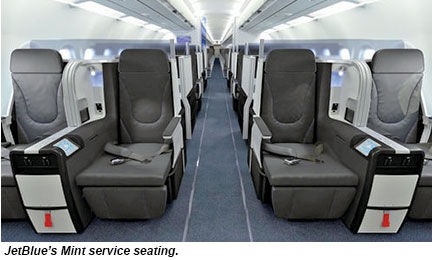The U.S. aviation industry heads into 2014 with fewer airlines than ever, more differentiated products and a more conciliatory attitude about the contentious subject of selling ancillaries through GDSs.
Each of those points promises to introduce substantial change to the industry in the year ahead.
American Airlines’ emergence from bankruptcy Dec. 9 and its merger with US Airways left the country with four mega-carriers and seven other jet airlines.
The Big Four are American, the last of the majors to go through bankruptcy; Delta Air Lines; United Airlines; and Southwest Airlines. The others are Alaska Airlines, Allegiant Air, Frontier Airlines, Hawaiian Airlines, JetBlue Airways, Spirit Airlines and Virgin America.
“That’s all that’s left,” said Michael Boyd, president of Boyd Group International, an aviation consulting firm in Denver. The result, he said, is a more stable marketplace for consumers and travel agents.
Part of that stability, he said, arises from the fact that each of the majors has its own strategy. They’re no longer trying to shift market share on battles waged on price and frequent flyer miles. Instead, they’re focusing on differentiating themselves using ancillaries and working at becoming travel retailers.
Still, turf battles remain. The lie-flat seats that dominate first-class accommodations on transcontinental routes are evidence of an ongoing battle to win over high-margin business travelers.
 The most telling example was JetBlue’s moving away from the egalitarian service that had been its hallmark (with the exception of its Even More Legroom seats) to introduce premium service.
The most telling example was JetBlue’s moving away from the egalitarian service that had been its hallmark (with the exception of its Even More Legroom seats) to introduce premium service.
The new service, known as Mint, will launch in June and will feature lie-flat seats on transcon routes. Core will be its revamped economy product.
Pricing is changing, as well. Airlines are cutting back on their lowest fares.
After the Department of Justice settled its antitrust suit challenging the American merger, aviation consultant Robert Mann of R.W. Mann & Co. predicted, “There are likely to be fewer fares in the cheaper buckets available and more in the middle- and higher-priced buckets.”
The cheapest fares are disappearing because airlines can fill their planes without them. It’s part of the new economic model airlines have adopted in which sales of ancillaries are key.
“Ancillaries are the difference between making money and not making money,” said Mark Drusch, former airline executive and chief supplier relations officer for Fareportal, whose sites include CheapOair.com and OneTravel.com. “That is why everyone is focusing on understanding how to merchandise the product better.”
Airlines are just learning how to merchandise their ancillaries, he said, and will spend much of the coming year figuring out how to be retailers.
Drusch said that airlines are already researching exactly what consumers are willing to pay for which products and services.
The result, he and other observers predicted, will be a more complicated product that offers agents a way to add value.
Moreover, at least some airlines want agents to help them sell those ancillaries.
Earlier this fall, Delta previewed its Smart Travel Pack, a bundle of ancillary services it was offering through the holidays, at Delta Insights, an event for its top-producing retailers.
The product was well received, and after that meeting, a Delta spokesman said the carrier has taken the first step in selling ancillaries through travel agencies by offering its Economy Comfort seats through two GDSs.
In the coming year, XML standards will continue to be a point of tension. IATA’s proposed New Distribution Capability (NDC) has been the subject of sometimes vicious debates in 2013 and will in all likelihood continue to stir all the stakeholders in aviation technology through much of next year.
Still, various players made unmistakably conciliatory moves last fall, suggesting that consensus might be possible.
At the ASTA Global Convention in September, one IATA executive said the group had erred in including only select agents in the NDC development process. Yanik Hoyles, NDC project director, offered ASTA a seat at the table.
“We made mistakes,” he said. “You guys are welcome.”
ASTA has participated in NDC meetings since then.
Then, in October, one GDS reached out to IATA. At the association’s World Passenger Symposium in Dublin, Travelport CEO Gordon Wilson said he was “very happy to work with IATA.” Wilson said after that meeting that IATA has listened to industry feedback.
And at the PhoCusWright Conference in November, speakers on an aviation panel predicted that a standard would evolve in the marketplace.
Moreover, they expressed excitement about what that would mean for industry stakeholders: direct conversations by the carriers with customers through intermediaries and comparison-shopping in a marketplace in which consumers would be able to see clearly how airline products are being differentiated.
Follow Kate Rice on Twitter @krtravelweekly.